| (insert your NIE or newspaper logo here) | Weekly Online LessonOnline Lesson ArchiveGrade Level: 5-8
|
Inaugurating a President
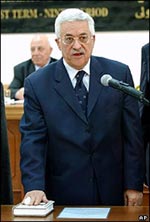 On
Saturday, January 15, 2005, Mahmoud Abbas was sworn in as the new president
of Palestine. His first order of business, made during his inaugural
speech, was to call for a ceasefire between Palestinian and Israeli
militants. Decades of conflict have killed or injured hundreds of people
on all sides.
On
Saturday, January 15, 2005, Mahmoud Abbas was sworn in as the new president
of Palestine. His first order of business, made during his inaugural
speech, was to call for a ceasefire between Palestinian and Israeli
militants. Decades of conflict have killed or injured hundreds of people
on all sides.
Ensuring the security, stability, and prosperity of his people is a president's top priority.
But, as Abbas already knows, achieving that will take much more than a speech can deliver. After all, the mutual distrust between Palestine and Israel runs strong and deep, and years of peacemaking efforts have gone nowhere.
Abbas isn't the only president to be sworn into office this month, facing a tough job ahead of him.
On January 20, President George W. Bush will take the Presidential Oath of office for his second term. This oath has been sworn 68 times since 1789, when George Washington became the first American president. Thursday's event will mark the 55th formal Inauguration ceremony.
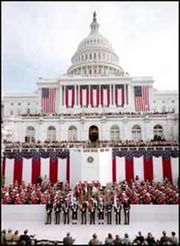 The
inaugural activities that take place at the U.S. Capitol are planned
by the Joint Congressional Committee on Inaugural Ceremonies (JCCIC).
This includes the swearing in of the President and Vice President, as
well as the traditional luncheon that follows the ceremony.
The
inaugural activities that take place at the U.S. Capitol are planned
by the Joint Congressional Committee on Inaugural Ceremonies (JCCIC).
This includes the swearing in of the President and Vice President, as
well as the traditional luncheon that follows the ceremony.
The Presidential Inaugural Theme the JCCIC has chosen is "A Vision of America." The committee says the theme "commemorates the anniversaries of two significant events in American history that helped shape the nation, the centennial of Theodore Roosevelt’s formal inauguration as president in 1905, and the bicentennial of the Lewis and Clark expedition reaching the Pacific in 1805."
Meanwhile, the President-elect usually plans additional activities to celebrate his inauguration. Bush planners, for example, are defining the event's theme as "Celebrating Freedom and Honoring Service." Related activities will begin Tuesday with a tribute to the military, and finish with a "Commander-In-Chief Ball" Thursday evening for 2,000 troops who have served or will be serving in Iraq or Afghanistan.
A president's inauguration ceremony, speech, and related activities often set the tone for the new administration's vision and goals for the nation. So in this week's lesson, you'll discover what's in store for the 2005 event and learn about the traditions and history of the U.S. Presidential Inauguration.
Inaugurating Tradition
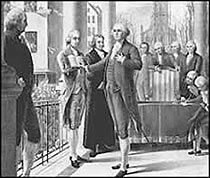 Let's
join the festivities in Washington, D.C., and meet with the JCCIC to
find out what they're planning for the 2005 Inauguration
of the President.
Let's
join the festivities in Washington, D.C., and meet with the JCCIC to
find out what they're planning for the 2005 Inauguration
of the President.
Read the introduction, and then click Inaugural '05. Click Ceremony to review the schedule of events and learn more about why the JCCIC chose the theme, "A Vision of America."
You can also find out what's planned for the Luncheon, including the Menu, the Painting that will provide the backdrop for the luncheon's most honored guests, and the Gift that will be presented to the President and Vice President.
Who will administer the Vice Presidential and Presidential oaths? Who else is involved, and what are their roles in the ceremony? In what ways will the theme be incorporated into the activities?
Now that we've got some idea of what to expect from Thursday's event, see how this compares to the event's History. Read the introduction, then check out the invitation and see the events of the day.
As you'll soon discover, sometimes Presidents and Presidents-elect attend a Morning Worship Service on Inauguration Day. Which church did George W. Bush attend before his first inauguration? At how many different places have Presidents-elect attended a prayer service?
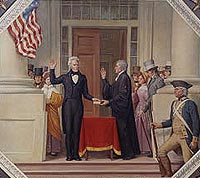 Afterward
comes the Procession
to the Capitol. How did this tradition become established?
Afterward
comes the Procession
to the Capitol. How did this tradition become established?
Soon after the party's arrival at the Capitol, the Vice President's Swearing-in Ceremony takes place.
When was the Vice President's oath established? Who takes this same oath? Who has administered this oath?
Following a musical interlude comes the Presidential Swearing-in Ceremony.
What was the first Inauguration like, and how did it compare to the second and subsequent ceremonies? Who was initially in charge of Inauguration, and when did that responsibility change hands?
In what ways did the circumstances of the day influence how and where the swearing-in ceremony was held? How many Vice Presidents have taken the Presidential oath?
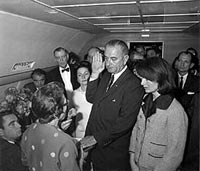 After
the swearing-in, the President gives his Inaugural
Address. What factors determine the tone of the speech?
After
the swearing-in, the President gives his Inaugural
Address. What factors determine the tone of the speech?
If you have time, follow the link to the Yale Law School's Avalon Project to read and compare inaugural speeches.
Following the address is the Inaugural Luncheon. How did this tradition evolve over the years?
Why is the Inaugural Parade an important part of the day's events?
Topping off the festivities is the Inaugural Ball. How has the party's format and budget varied over the years?
To wrap up our preparations for Inauguration 2005, let's browse the history of the Committee and Inauguration Facts & Firsts. Also check out the Chronology of inaugurations, where you can click on each President's name for details on his ceremony.
Who are some of the members of the JCCIC? In what ways did the character of the President-elect influence inaugural events? What other factors affected the ceremony?
Newspaper Activities
Review current issues of The Salt Lake Tribune to find articles about the 2005 Inauguration. In what ways is the media comparing this ceremony to previous ones? What topics did the President highlight in his inaugural address? In what way did the speech outline his vision and goals in leading the nation over the next four years? What are people's reactions to his speech? How did the intended themes play out during the event's activities?
Also look for stories about the swearing in of other American officials or ones in other countries. How do these ceremonies, and people's participation in or reactions to the event, compare with one another?
© Copyright 2005
Learners Online, Inc.
